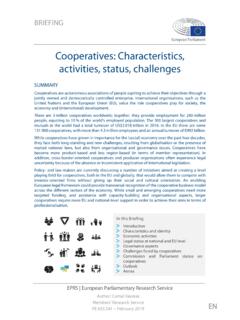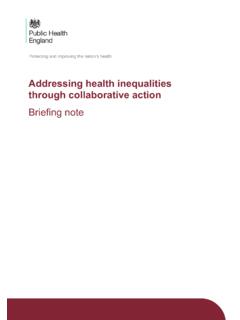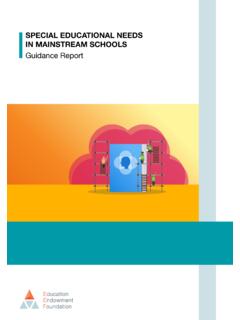Transcription of Collaborative Approaches to Preventing Offending and Re ...
1 Collaborative Approaches to Preventing Offending and re- Offending in children (CAPRICORN). A resource for local health & justice system leaders to support Collaborative working for children and young people with complex needs Collaborative Approaches to Preventing Offending and re- Offending In children (CAPRICORN). About Public Health England Public Health England exists to protect and improve the nation's health and wellbeing, and reduce health inequalities. We do this through world-leading science, knowledge and intelligence, advocacy, partnerships and the delivery of specialist public health services. We are an executive agency of the Department of Health and Social Care, and a distinct delivery organisation with operational autonomy.
2 We provide government, local government, the NHS, Parliament, industry and the public with evidence-based professional, scientific and delivery expertise and support. Public Health England Wellington House 133-155 Waterloo Road London SE1 8UG. Tel: 020 7654 8000. Twitter: @PHE_uk Facebook: Prepared by: Dr. Jo Peden, Sunita St rup-Toft, Rachel Bath, Dr. Amrita Jesurasa. Editor: Dr. amonn O'Moore Acknowledgements to: Jane Leaman, Professor Huw Williams, Dr Prathiba Chitsabesan, Sue Sylvester, Dr Tanya Richardson, Superintendant Stan Gilmour TVP, Kirsty Blenkins, Nino Maddelena, Dr Anna Richards, Maria Saltrese and Claire Dhami Infographics designed by Michael Heasman and Jo Peden For queries relating to this document, please contact: Crown copyright 2019.
3 You may re-use this information (excluding logos) free of charge in any format or medium, under the terms of the Open Government Licence To view this licence, visit OGL. Where we have identified any third party copyright information you will need to obtain permission from the copyright holders concerned. Published July 2019. PHE publications PHE supports the UN. gateway number: GW-507 Sustainable Development Goals 2. Collaborative Approaches to Preventing Offending and re- Offending In children (CAPRICORN). Contents About Public Health England 2. Glossary 4. Foreword 5. Executive summary 7. 1. Introduction 9. 2. Collaborative Approaches : a whole system approach 10. What is a whole system approach? 10. Clearly articulated vision 11.
4 Distributed leadership 11. Creating the right environment 11. Place based approach 11. Collaborative approach 12. Map and understand the system 12. Use data from across the system to build a local picture 13. Systems thinking 15. An asset-based approach 16. 3. Children and young people in contact with the youth justice system 18. 4. Understanding the health and social care needs of children in contact with justice services21. Health-related drivers of Offending behaviour for CYP 21. Adverse childhood experiences 22. Wider socio-economic determinants of health and Offending behaviour 25. 5. Consideration of risk and protective factors 26. Risk factors 26. Protective factors 27. 6. Developing a framework for action 29.
5 7. Upstream prevention: reducing Offending 31. Action at individual and family level 31. Giving the best start in life 32. Action at community level 35. 8. Downstream prevention: reducing re- Offending 51. Actions at individual and family level 51. Actions at community level 52. 9. Bringing it all together 60. Case study 1: The Reading Model 60. Case study 2: Building resilient communities to take action on ACEs in Gloucestershire 62. 10. References 65. 11. Appendix 72. 3. Collaborative Approaches to Preventing Offending and re- Offending In children (CAPRICORN). Glossary CCGs Clinical commisssioning groups CPS Crown Prosecution Service CSP Community safety partnerships CYPSE Children and young people's secure estate CYP Children and young people DfE Department for Education HCWs Healthcare workers HMPPS HM Prisons and Probation Service HWB Health and wellbeing boards ICS Integrated care systems LAC Looked-after children L&D Liaison and diversion services LTP NHS Long Term Plan MoJ Ministry of Justice NEET Not in education.
6 Employment or training NICE National Institute for Health and Care Excellence PCC Police and crime commissioners PHE Public Health England PPO Prison and Probation Ombudsman PTSD Post traumatic stress disorder SCH Secure children's home SEN Statement of educational need SOP Standard operating procedure STC Secure training centre STIs Sexually transmitted infections STPs Sustainability and transformation partnership TBI Traumatic brain injury YCS Youth Custody Service YOI Young offenders' institution YOT Youth Offending teams 4. Collaborative Approaches to Preventing Offending and re- Offending In children (CAPRICORN). Foreword I am delighted to be asked to write a forward to this timely and practical report.
7 Though we have seen significant reductions in the number of first time entrants to the justice system in the last 5 years and there are now fewer than 1,000 children in custody across England and Wales from a high of more than 3500 in 2005, there remain many challenges in Preventing children from getting involved in crime and helping those who have convictions to move on from their Offending and go on to become successful adults. In recent years, we have seen increases in knife crime and serious youth violence; this report sets out what we understand about the reasons why children offend and what can be done to prevent crime. It provides a useful description of the public health approach that has been so successful in reducing serious violence in Scotland, and in particular knife crime which has, against the trends in England and Wales, seen a sustained fall.
8 At the Summit on Serious Youth Violence in April 2019, the Prime Minister brought together ministers from across Government and other stakeholders to discuss the increases we have seen in violence in recent years. In her introductory remarks she set the tone that has been carried on through this report that we can't just arrest our way out this problem . Most of the solutions to youth crime lie outside the justice system and this report sets out the way in which a multi -agency, localised approach can be successful, as the evidence has showed to work in Scotland. Recent reviews by both David Lammy MP 1 and the Edward Timpson 2 have both alluded to the disproportionate number of children from BAME communities who are excluded from school and end up involved in the criminal justice system.
9 Both reports talk about the need for health, education, local authority children's services, youth Offending services, the police and other stakeholders to come together, and plan to support the most vulnerable children and their families in the knowledge that children who perpetrate crimes are often themselves victims. This report represents an important milestone in putting in place effective strategies to prevent crime and keep children safe. Above all it sets out the need for leadership at every level, from central government, the police, local authorities, local health boards and the third sector in order to give the space and scope to develop solutions that are best suited to the local context. Rather 1 2.
10 5. Collaborative Approaches to Preventing Offending and re- Offending In children (CAPRICORN). than be prescriptive about processes, recognising that what works in one place, may not work in another, what is set out here are the principles of how an effective, public health approach to children involved with crime can work. It shows the way that with effective co-ordination, collaboration and determination we can protect communities, reduce the numbers of victims of crime, and, help children to go on to lead constructive lives. Yours sincerely, Charlie Taylor Chair Youth Justice Board for England and Wales 6. Collaborative Approaches to Preventing Offending and re- Offending In children (CAPRICORN). Executive summary Children and young people in contact with the justice system have been shown to have poorer health outcomes than children in the general population.


















